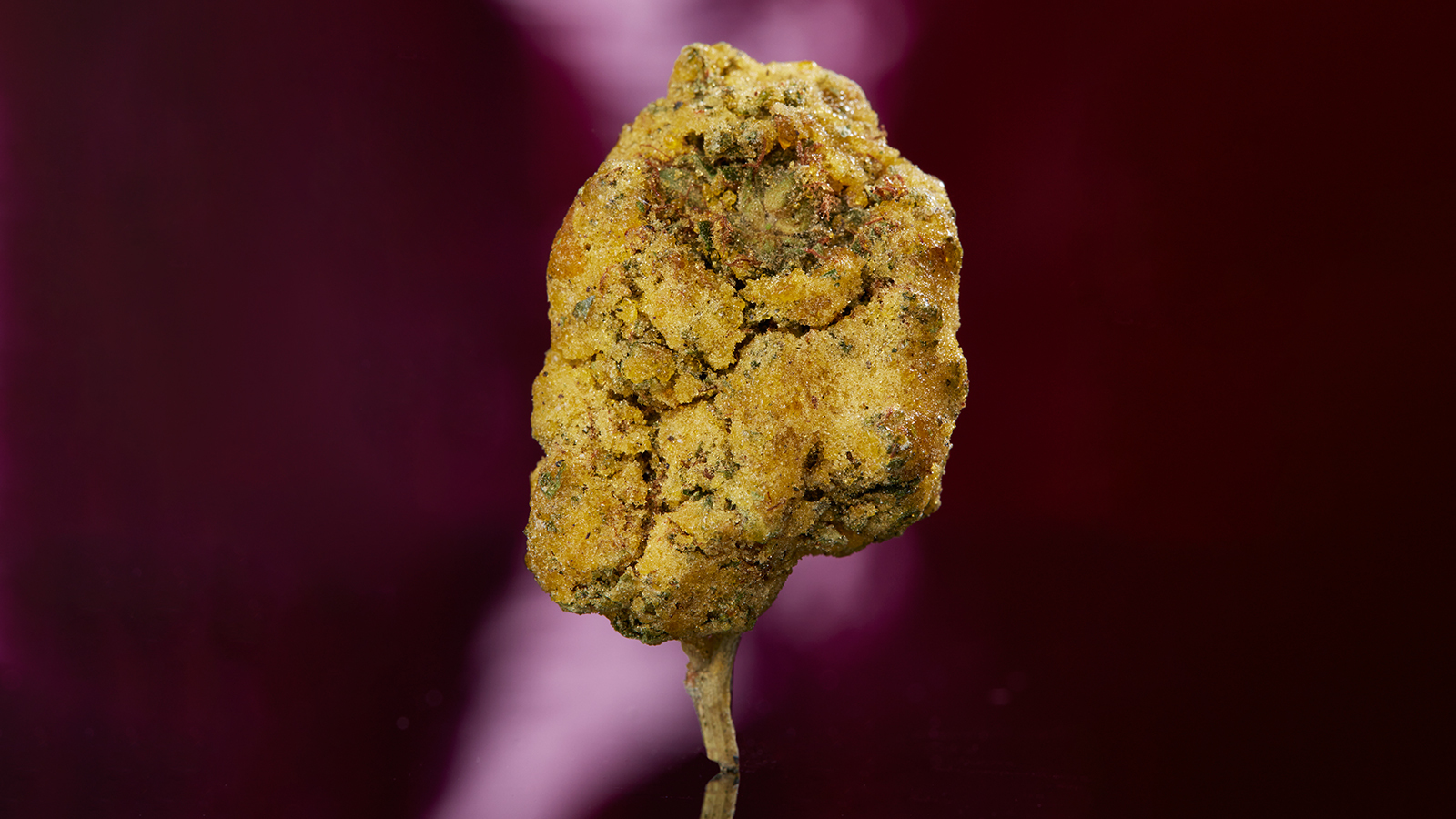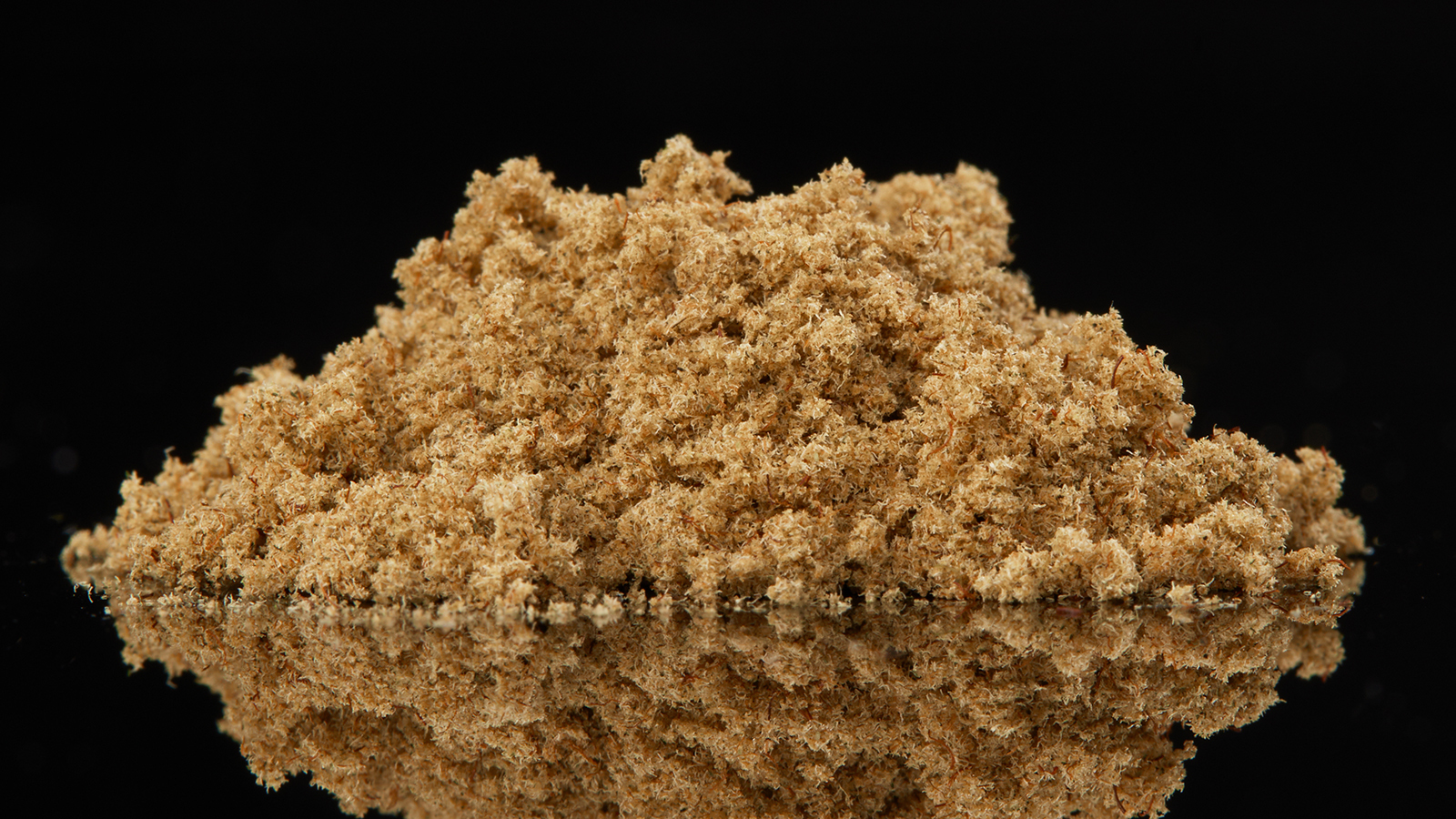A pre-roll is simply a joint that's readily made and can be found at almost any dispensary, and as the market has grown, many brands have started offering infused pre-rolls, bulking up the THC content for a potent edge. Learn more about them and find out how you can make your own infused joints at home.
What are infused pre-rolls?
Infused pre-rolls contain concentrates either rolled inside the joint or on the outside of the paper — some are a combination of both.
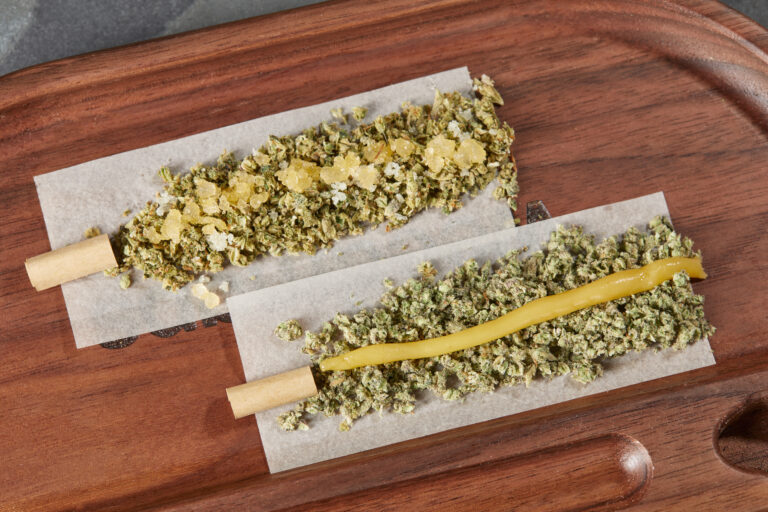 Photo by: Gina Coleman/Weedmaps
Photo by: Gina Coleman/WeedmapsImage lightbox

They can be purchased individually in easily transportable tubes or pre-packaged multi-packs, and usually come in strain-specific rolls that vary in size and potency.
How much do infused pre-rolls cost?
Since infused pre-rolls contain more than flower, expect the price points to be higher than a regular joint. In most markets, you can find infused pre-rolls between $12 - 25 for 1 - 1.5 grams of cannabis.
What concentrates are used in infused pre-rolls?
There are many concentrate options available for infusions:
Kief or Hash
 Photo by: Gina Coleman/Weedmaps
Photo by: Gina Coleman/WeedmapsImage lightbox

Two concentrates that are relatively easy to collect or make, kief and hash are both popular choices.
- Kief: The term for the accumulated loose trichomes identified as the greenish powder left in a grinder after grinding fresh cannabis flower. Easily mixed into joints and blunts or sprinkled on top of bowls, kief is likely the cheapest and most readily available option for handmade infused joints and it can enhance both the flavor and potency of your pre-roll. Its powdery nature makes it easy to blend with ground herb and ensures a smooth and even airflow through the joint.
- Hash: Hashish, also known as hash, is a concentrated form of cannabis that is derived from the resinous trichomes of the cannabis plant. To create hashish, the trichomes are separated from the plant material through various physical methods, such as sieving, shaking, or with ice and water. The collected resin is then typically pressed or heated to form a solid or semi-solid mass, which is the hashish. Widely considered one of the original concentrates that date back centuries, hash is solid and it's best to break it down into smaller pieces when infusing into a joint. Sharp edges and big chunks of it can rip rolling papers and create a loosely packed and poorly smoking joint.
Live resin extracts
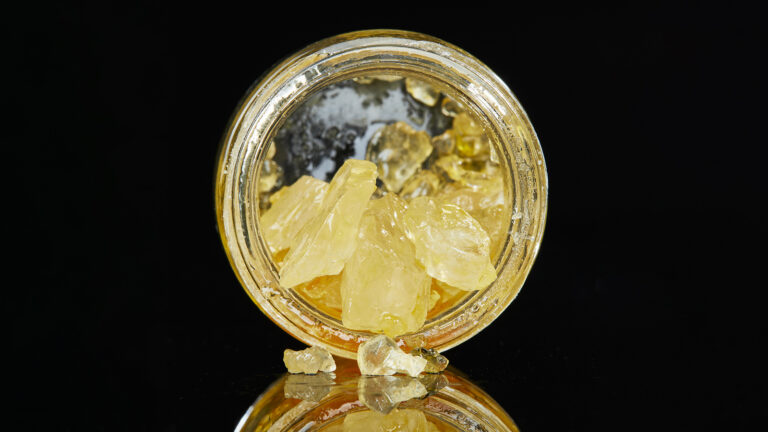 Photo by: Gina Coleman/Weedmaps
Photo by: Gina Coleman/WeedmapsImage lightbox

Live resin comes in many consistencies:
- Shatter: Shatter is extracted using a solvent. Like other forms of butane hash oils, shatter is known for its high potency and is often regarded as one of the purest forms of concentrate. Although it may be more popular for dabbing, it can be sprinkled into a joint or warmed up and used to coat the outside.
- Sauce: With a sticky and liquid-like consistency, sauce holds onto terpenes during the extraction process and is commonly consumed alongside diamonds. Sauce is usually rich in flavor and can compliment the already fresh taste of regular flower.
- Diamonds: Diamonds are the crystals that form in sauce. They are essentially flavorless since they are made up of 100% cannabinoids and contain almost no terpenes. While typically dabbed with the addition of sauce for flavor, diamonds have found their way into pre-rolls. Diamonds contain THCA, which is non-intoxicating on its own but converts to intoxicating THC once heated through decarboxylation. Due to the high purity and labor involved in its extraction, diamonds are a little pricier and highly revered for potency.
- Budder: A creamier concentrate, budder has a consistency similar to butter or cake batter. It's achieved by purging solvents at higher temperatures and pressures. Due to its creamy texture, it can easily be added to joints or blunts.
- Crumble: Crumble is a dry and honeycomb-like concentrate created through solvent extraction — it can be added to any joint for an infused experience.
Rosin
 Photo by: Gina Coleman/Weedmaps
Photo by: Gina Coleman/WeedmapsImage lightbox

Made by applying heat and pressure to cannabis flower or hash, rosin can be made at home or found in almost any dispensary. It's an excellent at-home option for handcrafted joints.
Consistencies of rosin include:
- Fresh press: Maintains a sap-like consistency that can be dabbed.
- Cold cure: Rosin that's left to cure at low temperatures. It's whipped after, resulting in a smooth and creamy consistency.
- Jam/Sauce: Rosin that has a viscous and syrupy texture, similar to the consistency of jam or sauce.
- Solventless diamonds: Rosin in a crystalline structure that resembles diamonds. It's produced without the use of solvents, resulting in a clean and pure extract.
Moon rocks
 Photo by: Gina Coleman/Weedmaps
Photo by: Gina Coleman/WeedmapsImage lightbox

A fairly recent development praised for their potency — averaging around 50% THC — moon rocks are made by dipping nugs of cannabis flower into cannabis extracts, which are then rolled in kief. While some retailers offer moon-rock-infused pre-rolls, they can require a bit more effort to smoke and may not be the easiest option to make at home.
Moon rocks are sometimes referred to as “cannabis caviar," but that term is technically reserved for buds dipped in extract but not rolled in kief. The terms are generally interchangeable, but if you're shopping at a retailer and the budtender mentions caviar, double-check with them so you know you're getting what you want.
How to make an infused pre-roll
Making your own infused pre-roll is a handy skill. The materials needed are the same as a joint or regular pre-roll, differing only with the addition of concentrates.
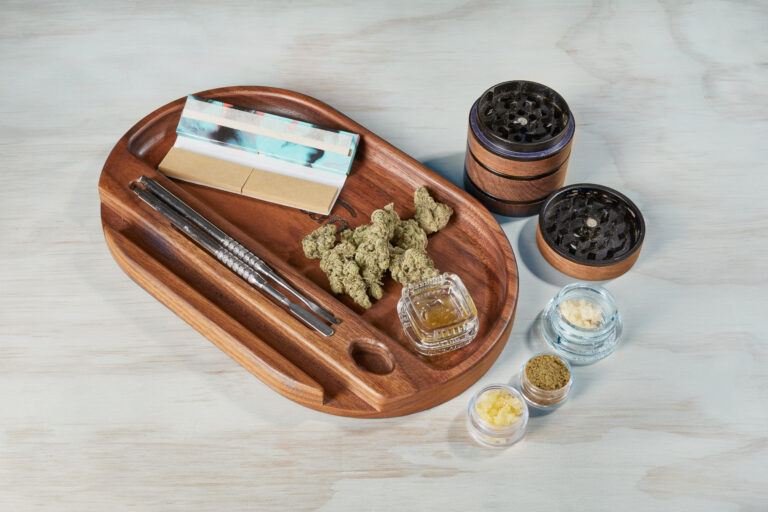 Photo by: Gina Coleman/Weedmaps
Photo by: Gina Coleman/WeedmapsImage lightbox

Since concentrates vary widely in texture and consistency, you may prefer to work with some over others. Each option will produce slightly different results, so experiment and try different combinations to find works for you.
Materials
- Rolling papers
- Filter
- Grinder
- Metal dab tool
- Sheet of paper
- ½ to 1 gram of cannabis
- Concentrate(s) of choice
Step 1: Grind cannabis
 Photo by: Gina Coleman/Weedmaps
Photo by: Gina Coleman/WeedmapsImage lightbox

Break up your buds and grind the cannabis.
Step 2: Warm up concentrate
 Photo by: Gina Coleman/Weedmaps
Photo by: Gina Coleman/WeedmapsImage lightbox

Depending on the type of concentrate you use, you can warm them up to make them easier to apply to the joint. Gently warm in natural sunlight or between the palms of your hands.
Step 3: Form filter or crutch
 Photo by: Gina Coleman/Weedmaps
Photo by: Gina Coleman/WeedmapsImage lightbox

Filters, also called crutches, are key to an enjoyable experience since they prevent bits of flower from entering your mouth and can mitigate burned lips when the joint is down to the roach.
To form it, fold the filter paper in a zigzag on one end. Once you've reached the halfway point, roll the remaining paper around the zigzag to secure it in place.
Note: Folding too tightly will result in the joint not pulling, too loose would lead to the joint falling apart.
Step 4: Form the joint paper
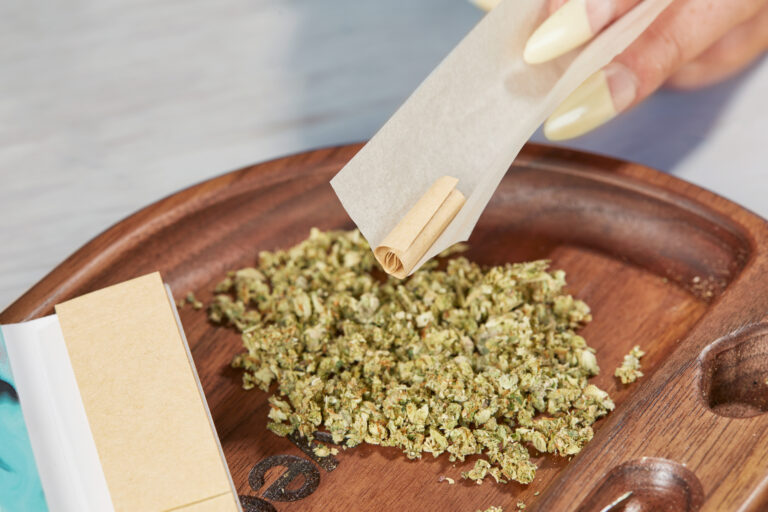 Photo by: Gina Coleman/Weedmaps
Photo by: Gina Coleman/WeedmapsImage lightbox

Grab your paper and fold it in half horizontally. Place the filter on the smoking end of the joint and set it down on your rolling surface.
Step 5: Fill joint with flower
 Photo by: Gina Coleman/Weedmaps
Photo by: Gina Coleman/WeedmapsImage lightbox

Place ground cannabis along the folded crease.
Step 6: Fill joint with concentrate
 Photo by: Gina Coleman/Weedmaps
Photo by: Gina Coleman/WeedmapsImage lightbox

If you're placing your concentrate inside of the joint, sprinkle it along the ground flower. You can use a metal dab tool to mix it in periodically.
If you're infusing your pre-roll on the outside, use softer, more malleable concentrates like wax or sauce. They will be more effective since their gooey nature allows them to evenly cover or spiral the surface of the joint. They can also act as a glue for other concentrates like kief, creating something akin to a moon rock joint.
Step 7: Roll and seal
 Photo by: Gina Coleman/Weedmaps
Photo by: Gina Coleman/WeedmapsImage lightbox

Wrap the rolling paper around the cannabis and concentrate, then seal it by dragging your tongue across the end of the paper and securing it in place. Add more concentrates to the outer paper, or smoke as is.
Step 8: Enjoy
 Photo by: Gina Coleman/Weedmaps
Photo by: Gina Coleman/WeedmapsImage lightbox

Once crafted, enjoy your work and smoke it like you would any other joint.
How to roll a donut joint
You can roll what is referred to as a “donut joint” by creating a line of concentrate that rests on a layer of ground cannabis, which is then covered in more flower before getting rolled into a cone.
 Photo by: Gina Coleman/Weedmaps
Photo by: Gina Coleman/WeedmapsImage lightbox

The joint will burn with the concentrate hollowing out the middle, thus creating a "donut hole."
Why choose infused pre-rolls?
With a large and potent variety, affordability, and convenience, infused pre-rolls are a prime choice for joint lovers, people with a higher tolerance, or those who just want a pre-roll with a little extra oomph. Get creative and try your hand at a donut joint, or use different types of concentrates for an extra stoney experience.
Featured image by Gina Coleman/Weedmaps


